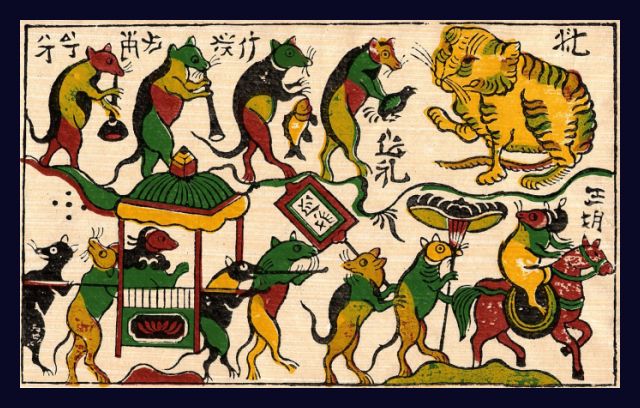Dong Ho folk painting - traditional cultural values
Dong Ho folk painting is a profession of making folk woodcarving paintings, belonging to the field of traditional crafts, which was created and developed by the community of Dong Ho villagers, Song Ho commune, Thuan Thanh district, Bac Ninh province with unique historical, cultural and artistic value.

A long time ago, Dong Ho painting used to be a precious decoration to celebrate Tet Holiday; Vietnamese people bought Dong Ho pictures to hang them on their wall for a year, and then replaced them by new ones when a new year was coming. Dong Ho painting has become a vivid symbol of folk culture in Vietnam and a source of inspiration for poets and musicians of many generations.
Apart from the beauty of lines and layouts, the folk feature of Dong Ho painting also lays on its color and paper; both are handmade and derived from materials available in nature. The paper is made of bark of tree named “do” and powder of seashells and glutinous rice whilst colors of paint used in Dong Ho pictures are processed from various kinds of natural materials easily found in Vietnamese villages. While seashells bring a sparkling white background, glutinous rice makes the paper suppler and able to conserve colors for a long time. The black color is taken from ash of burned bamboo leaves; the red is from red gravel; the yellow is from flowers. All colors are so striking and lively that you seem to see the whole Vietnamese villages through each line, each color block. Regarding themes of Dong Ho painting, it should be noted that the folk picture is a fine reflection of daily life, culture values, social philosophies and human aspiration for a better life in years coming; therefore, everyday life, folk allegories, social commentaries, mythical and historical figures, signs of happiness, luck, prosperity are main subjects of the painting.
Dong Ho folk paintings reveal the talents and ideology of Vietnamese people in the past. Making a painting requires 5 iterations of carving and inking wood blocks.
Dong Ho paintings bear significant historical, cultural and artistic values reflecting the beliefs and daily activities of people in the Red River Delta. This art genre has been recognized as a national intangible heritage. This recognition is expected to help preserve and develop the art while increasing the public’s awareness of traditional cultural values.
Over hundreds of years of development, Dong Ho folk paintings have become an indispensable “spiritual food” for a large number of people from all social strata in the country for many centuries.
Each painting has its own meaning, reflecting aspirations of the working class, from simple to sacred and noble things. Such paintings as “Vinh hoa” (Honour), “Phu quy” (Wealth), “Tien tai” (Richness), “Ga dai cat” (The rooster of good fortune), “Phuc” (Happiness) and “Tho” (Longevity) show the wishes for a new year.
Meanwhile, to commemorate national heroes, artisans created “Hai Ba Trung tru giac Han” (Trung Sisters defeat the Han enemy), “Ba Trieu danh quan Ngo” (Lady Trieu fights against the Wu troops), and “Ngo Vuong Quyen danh Nam Han” (King Ngo Quyen fights against the Southern Han troops), among others. To inspire the traditional fondness for learning and the respect for teachers, there are such works as “Hieu hoc” (Fond of learning), “Vinh quy bai to” (Returning home to pay tribute to ancestors after achieving academic honours), “Muc dong doc sach” (Herdsman reads book), and “Thay do coc” (Toad teacher).
Dong Ho paintings also criticize bad habits, vices, as well as injustice in society. Among them, “Dam cuoi chuot” (Mice’s wedding) is a profound satirical implication. The cat represents the ruling class that is greedy and eager for bribery while the mice, representing peasants, are wise and always stay alert to the cat. Meanwhile, “Danh ghen” (Jealousy) criticises men’s womanizing while secretly giving advice to them to help prevent a family tragedy.
“Tu quy” (The four seasons), “Tung hac” (The pine and the crane), “Ke cuc” (The rooster and the chrysanthemum), “Lien ap” (The lotus and the duck) imply the virtues of honorable persons. There are also paintings depicting traditional cultural activities of the daily life or festivals in the northern region like “Danh du” (Swinging), “Danh vat” (Wrestling), “Ruoc trong” (Drum procession), “Mua rong” (Dragon dancing), “Mua lan” (Kylin dancing), and “Choi trau” (Buffalo fighting).






